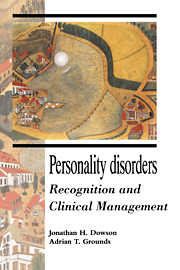Book contents
- Frontmatter
- Contents
- Acknowledgement
- Part One Recognition
- 1 Personality disorders: basic concepts and clinical overview
- 2 Specified personality disorders: clinical features
- 3 Personality disorders: less specific clinical presentations and epidemiology
- 4 Longitudinal aspects of personality disorders
- 5 Assessment of personality disorders
- Part two Clinical management
- References
- Index
5 - Assessment of personality disorders
from Part One - Recognition
Published online by Cambridge University Press: 19 October 2009
- Frontmatter
- Contents
- Acknowledgement
- Part One Recognition
- 1 Personality disorders: basic concepts and clinical overview
- 2 Specified personality disorders: clinical features
- 3 Personality disorders: less specific clinical presentations and epidemiology
- 4 Longitudinal aspects of personality disorders
- 5 Assessment of personality disorders
- Part two Clinical management
- References
- Index
Summary
Nature of personality disorders
The ingredients of PDs consist of higher mental activity such as attitudes, beliefs, motivations and feelings, and associated overt behaviour. However, only the overt behaviour, which includes speech, is available for investigation. Behaviour related to PDs has three characteristics: a varying degree of repetition, which means that future behaviour can be predicted; some degree of generalizability in which specified behaviour is shown in a range of situations; and some impairment or distress. But even relatively uncomplicated behaviours, such as driving recklessly, are subject to variability when repeated, and precise specification of behaviour is difficult.
A trait, such as sociability, is the most commonly used basic unit to describe and define PDs, and consists of a group of related behaviours. But each trait is also a theoretical entity which involves relationships between aspects of higher mental activity. In the main current definitions of PDs, traits vary in the number of related behaviours, in the degree of reliance on specified behaviours and on the nature of associated aspects of higher mental activity, such as motivation. The trait approach to PD also involves higher-order theoretical entities, in which several traits are combined to form a smaller number of broader dimensions, while lower-order or ‘fine-grain’ examples of specified behaviour have been included in definitions of some features of PDs.
- Type
- Chapter
- Information
- Personality DisordersRecognition and Clinical Management, pp. 195 - 230Publisher: Cambridge University PressPrint publication year: 1995
- 2
- Cited by



